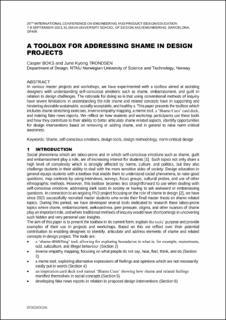A Toolbox for addressing shame in design projects
Chapter
Published version

Åpne
Permanent lenke
https://hdl.handle.net/11250/3101532Utgivelsesdato
2023Metadata
Vis full innførselSamlinger
- Institutt for design [1054]
- Publikasjoner fra CRIStin - NTNU [37221]
Originalversjon
10.35199/EPDE.2023.69Sammendrag
Partly because of societal developments and partly because of a targeted recruitment strategy, social phenomena which are taboo-prone and in which self-conscious emotions such as shame, guilt and embarrassment play a role, are of increasing interest for students [1]. Such topics not only share a high level of complexity which is strongly affected by norms, culture and politics, but they also challenge students in their ability to deal with the more sensitive sides of society. Design education in general equips students with a toolbox that enable them to understand social phenomena, to raise good questions, map contexts by using interviews, surveys, focus groups, cultural probes and use of other ethnographic methods. However, this toolbox becomes less straightforward to use when taking on topics where self-conscious emotions, addressing awkwardness, having to ask embarrassing questions, and identifying and highlighting dark spots play a prominent role. In connection to an ongoing PhD project focusing on the role of shame and taboo in design [2], for three years we have actively recruited master students to write their final master thesis on shame related topics. During this period, we have developed several tools dedicated to gaining user insights about these taboo-prone topics where shame, embarrassment, awkwardness, peer pressure, stigma and other nuances of shame obviously play an important role. The tools aim to help designers uncovering feelings, thoughts, opinions and insights which would likely not be shared through traditional methods of inquiry – of course while keeping the highest ethics standards doing so. This paper presents the toolbox which consists of • a ‘shame-stretching’ tool, allowing for exploring boundaries in what is, for example, mainstream, odd, subculture, and illegal behaviour. • inverse empathy mapping, focusing on what people do not say, hear, feel, think and do. • a meme tool, exploring alternative expressions of feelings and opinions which are not necessarily easily put in words • an inspiration card deck tool showing how shame and related feelings manifest themselves in social concepts. The use of the toolbox is illustrated by sharing examples of its use in practical projects. The paper concludes with reflections by both students and supervisors on using these tools and how they complement the standard designers’ toolbox.